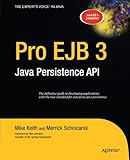Mike Keith
Co-specification lead of EJB 3.0, co-author of "Pro EJB 3: Java Persistence API"

Mike Keith has over 15 years of teaching, research and practical experience in object-oriented and distributed systems, specializing in object persistence. He was the co-specification lead for EJB 3.0 (JSR 220) and a member of the Java EE 5 expert group (JSR 244) and co-authored the premier JPA reference book called Pro EJB 3: Java Persistence API. He is currently an architect for Oracle TopLink and the Oracle OC4J Container and is a popular speaker at numerous conferences and events around the world.
Presentations
Books
by Michael Keith and Merrick Schincariol
-
Enterprise JavaBeans 3.0 (EJB 3.0) is a vital component of the new Java Enterprise Edition 5 platform (previously called J2EE). They are used for the development and deployment of component-based enterprise business applications.
Ever since its first release, EJB has been the subject of much media attention and no little controversy. EJBs represent a sophisticated and powerful technology and EJB-based applications can support high numbers of transactions and users, with maximum security.
However, previous incarnations of EJB have come to be regarded by many as an overly complex technology that can lead to costly and time-consuming solutions that are difficult to build, implement and maintain.
EJB 3 is set to change all that. It has made huge advances in ease of development, and its drastically simplified programming model has been widely acclaimed and embraced. At the heart of the new EJB 3 spec is a massive reduction in the complexity of the EJB persistence and object-relational mapping mechanisms (essentially the entity beans portion of the specification).
This book provides the definitive guide to the EJB 3 persistence technology. The lead author, Mike Keith, is a co-lead on the EJB 3.0 expert group (under JSR 220) and provides unparalleled insight and expertise on this topic. He and his co-authors dissect and explain the new EJB 3 persistence specification in full detail, describing how to use this sophisticated technology to its full potential.
Assuming a basic knowledge of Java, SQL, JDBC and some J2EE experience, this book teaches you EJB 3 persistence from the ground up. It provides the reader with a complete and in-depth understanding of the EJB 3.0 Persistence API and how to use it in practice.
-
Enterprise JavaBeans 3.0 (EJB 3.0) is a vital component of the new Java Enterprise Edition 5 platform (previously called J2EE). They are used for the development and deployment of component-based enterprise business applications.
Ever since its first release, EJB has been the subject of much media attention and no little controversy. EJBs represent a sophisticated and powerful technology and EJB-based applications can support high numbers of transactions and users, with maximum security.
However, previous incarnations of EJB have come to be regarded by many as an overly complex technology that can lead to costly and time-consuming solutions that are difficult to build, implement and maintain.
EJB 3 is set to change all that. It has made huge advances in ease of development, and its drastically simplified programming model has been widely acclaimed and embraced. At the heart of the new EJB 3 spec is a massive reduction in the complexity of the EJB persistence and object-relational mapping mechanisms (essentially the entity beans portion of the specification).
This book provides the definitive guide to the EJB 3 persistence technology. The lead author, Mike Keith, is a co-lead on the EJB 3.0 expert group (under JSR 220) and provides unparalleled insight and expertise on this topic. He and his co-authors dissect and explain the new EJB 3 persistence specification in full detail, describing how to use this sophisticated technology to its full potential.
Assuming a basic knowledge of Java, SQL, JDBC and some J2EE experience, this book teaches you EJB 3 persistence from the ground up. It provides the reader with a complete and in-depth understanding of the EJB 3.0 Persistence API and how to use it in practice.
